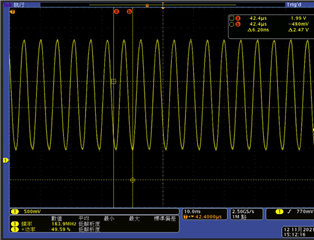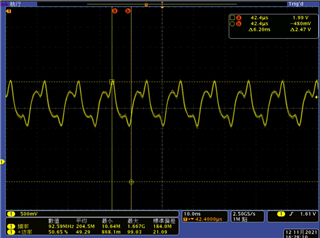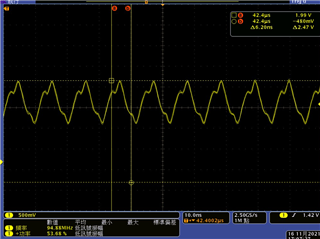Hi Team,
I used below setting to set LMK61E2M output frequency. (92Mhz and 184Mhz)
The 184MHz behavior looks good, but 92MHz is not ok. We tried 94MHz 90MHz and 91MHz, and the behavior were similar. Can you help me how to fix it?
R0 0x0010 R1 0x010B R2 0x0200 R8 0x08B0 R9 0x0901 R16 0x1000 R17 0x1180 R20 0x1400 R21 0x1511 R22 0x1600 R23 0x1706 R24 0x1810 R25 0x1900 R26 0x1A33 R27 0x1B00 R28 0x1C00 R29 0x1D0D R30 0x1E00 R31 0x1F00 R32 0x2019 R33 0x2103 R34 0x2224 R35 0x2327 R36 0x2418 R37 0x2502 R38 0x2602 R39 0x2707 R47 0x2F00 R48 0x3000 R49 0x3110 R50 0x3200 R51 0x3300 R52 0x3400 R53 0x3500 R56 0x3800 R72 0x4802

R0 0x0010 R1 0x010B R2 0x0200 R8 0x08B0 R9 0x0901 R16 0x1000 R17 0x1180 R20 0x1400 R21 0x1511 R22 0x1600 R23 0x170D R24 0x1810 R25 0x1900 R26 0x1A33 R27 0x1B00 R28 0x1C00 R29 0x1D0D R30 0x1E00 R31 0x1F00 R32 0x2019 R33 0x2103 R34 0x2224 R35 0x2327 R36 0x2418 R37 0x2502 R38 0x2602 R39 0x2707 R47 0x2F00 R48 0x3000 R49 0x3110 R50 0x3200 R51 0x3300 R52 0x3400 R53 0x3500 R56 0x3800 R72 0x4802

Schematic.

Roy


